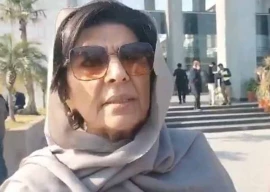
This greeting is onboard the farthest human-made object from the Earth: Voyager 1. Launched in 1977, Voyager 1 provided the first close-up pictures of Jupiter and Saturn, before starting its journey out of our Solar System. After 35 years of travels, it is now roughly 19 billion kilometers from the Earth. There is another way to think about this distance. A radio message from the Sun would take only eight minutes to get to us. From Voyager 1, it currently takes 17 hours! Furthermore, the distance between us and this assalam alaikum will only keep on growing.
Urdu is not the only language onboard. There are greetings in 55 world languages, including Akkadian, a language once spoken in Mesopotamia four thousand years ago. These greetings are stored on a golden record onboard Voyager 1. In addition to welcoming messages, the 90-minute record contains music (from Beethoven’s 5th symphony and Chuck Berry’s Johnny B. Goode to Senaghalese percussion and Raag Bhairvi), natural sounds (from wind and thunder to croaking frogs and bird songs), and 115 pictures depicting life here on Earth (you can listen to and see all the contents at goldenrecord.org). If in the far-far future, some alien race encounters Voyager 1 spacecraft, they will get a glimpse of life and culture here on Earth — at least as envisioned by astronomer Carl Sagan and his associates for Nasa in the seventh decade of the 20th century.
But in its outward journey, Voyager 1 can also tell us about the boundary of our Solar system. This is a hard task. There are no ceremonial displays of national identities, like at the Wagah border. There are no billboards in space saying that you are now leaving the Solar system. Nor are there any border checkpoints that may look at the nationality of Voyager 1 with suspicion.
One way to define the “border” of our Solar system is by its Heliosphere. Within this region we are likely to encounter most particles — electrons and protons, in this case — that are emitted by the Sun as part of its steady Solar wind. But, our Solar system also contains particles — mostly protons — that were once produced inside exploding stars and now fill up the space within our Galaxy. Instruments on Voyager 1 can distinguish between these two types of particles — the locals and the visitors from outside. The boundary of our Solar system, then, can be defined as the place where the number of particles from the wider Galaxy starts outnumbering the particles from our Sun. This is our border.
Just this past year, humanity’s farthest object reached such a border: the number of Solar wind particles dropped precipitously — by more than a thousand. During the same period of time, the number of particles from the Galaxy increased ten-fold. It seems that Voyager 1 is now in the process of entering interstellar space.
The spacecraft is not aimed at any particular star. But in 40,000 years, it will pass close to a small star named Gliese 445. We do not even know if there are any planets around this star, let alone any life capable of detecting and capturing Voyager 1. But if some thinking beings do end up playing the Golden Record, they will also get to see a picture of a lively street scene from Pakistan — inhabitants that speak Urdu. We will be long gone by that time, and it is impossible to predict the future of humanity four thousand decades from now. However, our Urdu greeting will sound as fresh as ever.
In the mean time, on this planet, Eid Mubarak!
Salman Hameed is associate professor of integrated science and humanities at Hampshire College, Massachusetts, USA. He runs the blog Irtiqa at irtiqa-blog.com
Published in The Express Tribune, Sunday Magazine, August 11th, 2013.
Like Express Tribune Magazine on Facebook, follow @ETribuneMag on Twitter to stay informed and join the conversation.
COMMENTS (14)
Comments are moderated and generally will be posted if they are on-topic and not abusive.
For more information, please see our Comments FAQ





































@Ramesh: It is Confirmed that Urdu, Hindustani, Kharriboli, and Hindi before 1967 was the Language of Indian Muslims, Developed in Muslim Majority areas and Named by Hindustani Muslims, It was Called Hindi Language of Hindustani People, But When Hindu People Claimed it in Era of Sir Syed Ahmad Khan in 1867 However its Style Was Pro-Arabic, Than Sir Syed Felt the Conservatism of Hindus and He Changed Its name to Urdu, Now National Language of Bharat is Modern Hindi, Not Hindi of That Days When Muslims Were Struggling to Take Control BACK of The Whole Indian Subcontinent from British in 1857, So You Must have Clear the Real Meanings of INDIA, Now You People are living in Bharat, Not in United Indian Continent and Hindustan of That times when it was Shared by Muslims Hindus, Sikhs, and The Other Minorities..., You Must Realize that 700 Years ago there Ware Muslims Who Were Ruling India, and They Have A Great Role in Development of Kharriboli, Hindustani, Rekhta, Urdu-e-Mualla, And Modern day Urdu...Got it....
Firstly, Hindi & Urdu - both earlier known as Hindustani - were developed from the Khariboli dialect - though they incorporate Persian, Arabic & Turkic vocabulary also. Khariboli itself derived from the Shauraseni language, which has its roots in Prakrit & Sanskrit.
Secondly, both Hindi & Urdu were developed in India & are national languages of India. Pakistanis have no stake in their development. In fact, they were fully developed at least 700 years before the advent of the name 'Pakistan' - which was coined in 1933 by Choudhary Rahmat Ali.
So, the question arises why are Pakistanis - who are mainly Punjabis but also Sindhis, Seraikis, Pashtuns, Balochs, etc. - chasing Urdu which is neither their mother tongue nor was developed in that area?
Voyager uses nuclear power batterey to power its radio,it also has camera on it but it was shut down way back in order to conserve power and increase the life of this mission upto 2025.But our universe is so big that even after travelling till 2025 at the speed of 60000 km/hr we will not be able to reach even 1% of the distance to our closest star so it wont be wrong for us to say that there will be many planets in universe where life do exist.
Salik - There is no friction in space, so Voyager 1 is traveling via inertia ("a body in motion will stay in motion...") and won't really slow down. It attained close to its current speed (17km/s or approximately 60,000 km/hour) using the gravity of Jupiter and Saturn as a slingshot (the process is called "gravity assist"). However, Voyager 1 does need a battery to send and receive signals from Earth. That battery is expected to runout by 2025. After that. Voyager 1 will continue its voyage, but we will never hear about any of its adventures.
@Salik:
Spacecrafts generally dont need fuel to travel longer distance. They can shut down their engine after being launched, they just keep on moving due to initial inertia and since space is vacuum there is no friction and hence no reduction in speed.
Usually they need fuel to change direction, to sling shoot from some orbit or to increase their speed.
Naturally why should they place the clips of "nuclear mushrooms" of Nagasaki and Hiroshima and their terrifying aftermath? We have no proof to refute that we humans are the most brutal and conscienceless predators in this infinite space! JUST STAY AWAY FROM US!
Great article. Its amazing how far the Voyager-1 has travelled. There is just one correction, the article mentioned radio signal from sun would take 8 minutes, I think it should be, the speed of light from sun, it takes 8 minutes for light to travel to earth and light is the fastest travelling thing known to mankind and it travels at 186,000 miles per second. Sun is at 93 million miles from Earth. So the distance to Voyager at Speed of Light would be 17 hours.
Salik - There is no friction in space to slow down Voyager 1 - so it is following its inertia ("a body in motion will stay in motion..."). Its current speed (17 km/s or close to 60,000 km/hr!) was attained by using the gravity of Jupiter and then of Saturn as a slingshot. This is called "gravity assist". While the spacecraft will likely keep on moving forever, its battery power source that allows it to receive and send signals back to Earth will likely run out by 2025. After that, it will be on its own, and we will never hear back about any of its subsequent adventures.
I had always heard about the golden disc and even read about it; however I didn't know there was a website featuring the contents of the disc! Very cool to see and very interesting to read. Well done Professor and thank you!
Wow. So how exactly is Voyager 1 powered. What's the source of energy it's using to keep moving ahead?
great..... very awesome
Good to see you back. Voyager I & II are one of the biggest accomplishments of humankind, and these small traces of our existence may float on in some distant corner of the universe even if all known life is extinguished on earth.